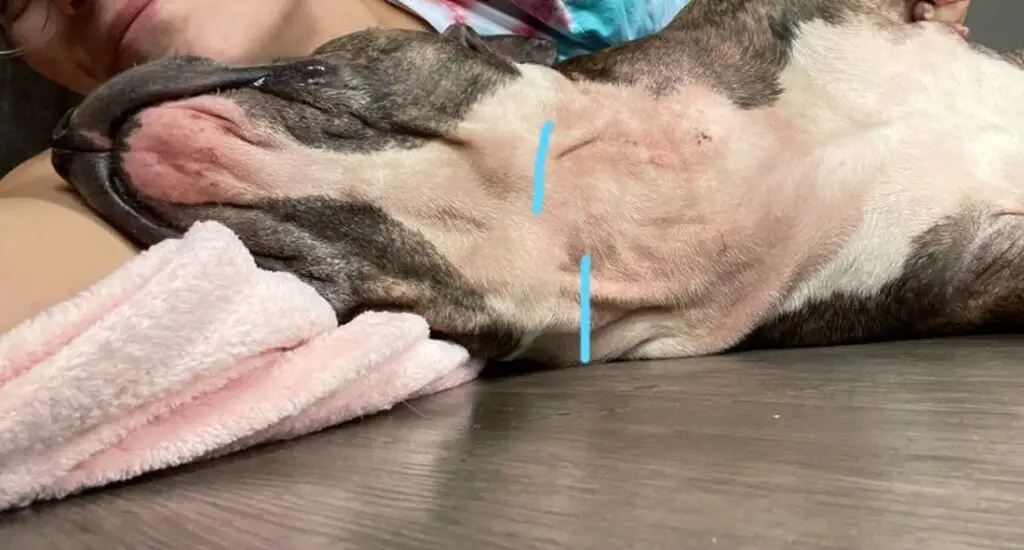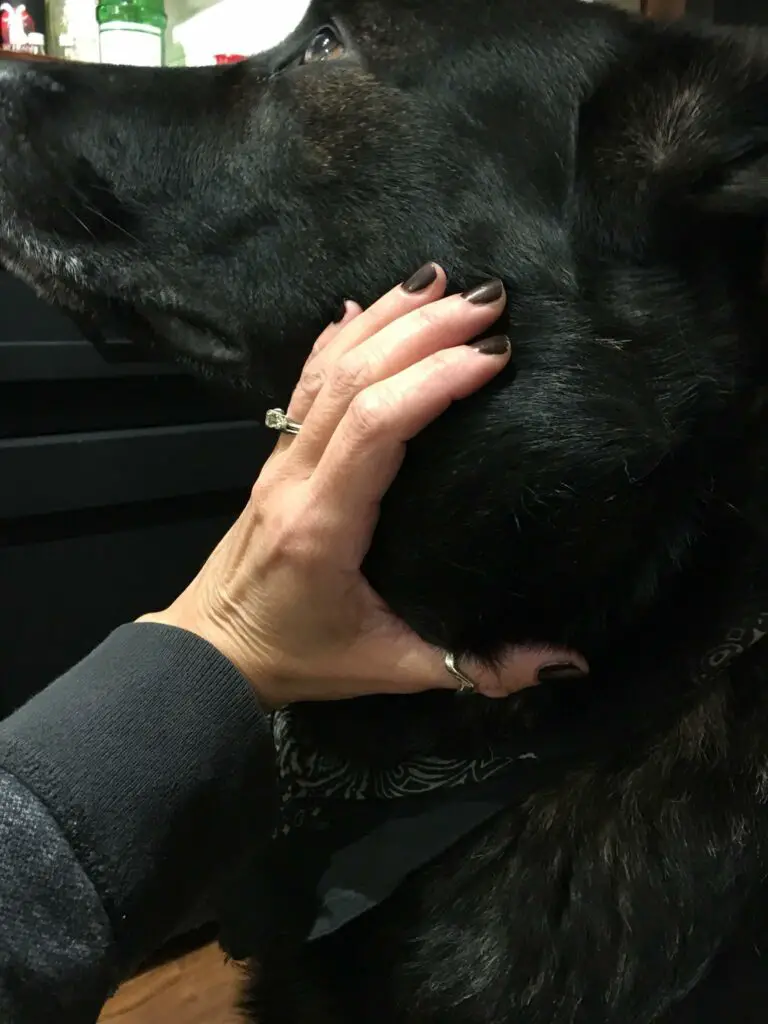This comprehensive guide is designed to help dog owners understand the location and function of their pet’s lymph nodes in the neck area.
With detailed descriptions and illustrative pictures, we aim to provide a clear understanding of how to detect changes in these nodes.
Whether you’re a new pet owner or an experienced dog lover, this post will equip you with essential knowledge about your furry friend’s health.
- Key Takeaway
- Primary Functions of The Lymph Nodes Located In a Dog’s Neck
- Where Are Dog Lymph Nodes In Neck?
- How Many Lymph Nodes Are Typically Present In a Dog’s Neck?
- Can You Normally Feel Lymph Nodes In Dog’s Neck?
- How Do I Know If My Dog’s Neck Lymph Nodes Are Swollen?
- Symptoms of Swollen Lymph Nodes In a Dog’s Neck
- What Causes Swollen Lymph Nodes In a Dog’s Neck?
- How Can Veterinarians Examine The Lymph Nodes in a Dog’s Neck For Signs of Illness or Infection?
- Treatment For Swollen Lymph Nodes in Dog’s Neck
- In Conclusion
Key Takeaway
- Dog lymph nodes in the neck, also known as cervical lymph nodes, are located just beneath the jawline on either side of the windpipe.
- The primary functions of the lymph nodes located in a dog’s neck are to filter harmful substances from the body, produce white blood cells for immune responses, and detect and respond to infections or diseases.
Primary Functions of The Lymph Nodes Located In a Dog’s Neck
The primary functions of lymph nodes located in a dog’s neck, also known as the submandibular lymph nodes, are to act as filters for the blood and lymph, storing additional white blood cells needed to fight infection.
They help in identifying and combating infections and diseases by trapping viruses, bacteria, and other foreign substances, which are then destroyed by lymphocytes, a type of white blood cell.
These nodes form a crucial part of the immune system, maintaining body fluid levels, absorbing digestive tract fats, removing cellular waste, and protecting the body from illness-causing invaders.
See also: Can Dogs Live Without Lymph Nodes?
Where Are Dog Lymph Nodes In Neck?

The lymph nodes in a dog’s neck are located on either side of the lower jaw where it meets the neck.
They play a crucial role in the immune system, acting as filters for the blood and lymph, storing additional white blood cells needed to fight infection.
To locate the lymph nodes in a dog’s neck, you’ll need to gently feel just beneath the jawline.
Start by getting your dog to sit or stand comfortably. Use your fingertips to lightly press against the skin beneath the jaw and slowly move your fingers back and forth. You’re looking for small, round structures that may feel like peas or beans beneath the skin.
Remember, in a healthy dog, lymph nodes are usually not noticeable. If the lymph nodes are swollen or enlarged, it could be due to an infection or other medical condition, and you should seek veterinary attention.
Some common areas where you can feel lymph nodes in dogs include either side of the windpipe, just below the jawline, and near the front legs.
See also: Can Dog Lymph Nodes Be Removed?
How Many Lymph Nodes Are Typically Present In a Dog’s Neck?

In the neck region, dogs typically have two main groups of lymph nodes and each group consists of one to several nodes.
The submandibular lymph nodes, located under the jaw, and the prescapular lymph nodes are found at the front of the shoulder blades near where the neck and shoulder meet.
Each group generally consists of one to several nodes. However, it’s important to note that the exact number can vary from dog to dog.
Some nodes may not be easily palpable or detectable unless they are enlarged.
See also: Can Dogs Lymph Nodes Swell From Allergies?
Can You Normally Feel Lymph Nodes In Dog’s Neck?
Under normal conditions, lymph nodes in a dog’s neck are small and may not be easily felt.
Submandibular lymph nodes located on either side of the lower jaw where it meets the neck, can sometimes be detected through careful palpation.
These nodes should feel about the size of a marble or less, depending on the size of your pet.
It’s important to note that if a lymph node is larger than normal, painful, or the area around it is swollen or painful, it should be examined by a veterinarian.
Swollen lymph nodes can vary in size. But, they are typically larger than normal and may feel firm or rubbery to the touch.
See also: 9 Causes Of Swollen Lymph Nodes In Dogs
How Do I Know If My Dog’s Neck Lymph Nodes Are Swollen?
Swollen lymph nodes in dogs usually feel larger than normal and can be detected through careful palpation near the jaw.
However, salivary glands also dwell in this area, and they can feel very similar to enlarged submandibular lymph nodes.
In a healthy dog, these nodes should feel about the size of a small pea or bean, depending on the size of the dog, and are usually soft and movable under the skin.
If the lymph nodes are swollen, they may feel larger, and firmer, and may even be visible under the skin.
Symptoms of Swollen Lymph Nodes In a Dog’s Neck
- Noticeable enlargement of the lymph nodes in the neck area
- Visible lumps or bumps under the skin
- Pain or discomfort when the area is touched
- Changes in behavior, such as lethargy or decreased appetite
- Difficulty swallowing or breathing, if the swollen nodes are pressing on the throat or airway
- Fever, as a response to infection
- Unexplained weight loss
- Increased thirst and urination, which can be signs of underlying disease
- Persistent cough or shortness of breath
- Skin redness or inflammation around the affected area
- Drainage or pus from the lymph nodes.
What Causes Swollen Lymph Nodes In a Dog’s Neck?
- Bacterial, viral, or fungal infections
- Immune system response to an allergen or foreign substance
- Inflammatory conditions, such as dermatitis or arthritis
- Parasitic infections, such as heartworm or tick-borne diseases
- Dental infections or periodontal disease
- Cancer, specifically lymphoma
- Systemic diseases like lupus or rheumatoid arthritis
- Certain medications or vaccines
- Physical trauma or injury to the area.
How Can Veterinarians Examine The Lymph Nodes in a Dog’s Neck For Signs of Illness or Infection?
Veterinarians use a process called palpation to examine the lymph nodes in a dog’s neck for signs of illness or infection.
During this physical examination, the vet can feel the lymph nodes that are closer to the skin, also known as palpable nodes. In a healthy dog, these nodes should be small and hard to detect.
However, if they are swollen, they may feel larger and firmer.
Lymph nodes that can be felt through the skin are located in a few areas including the submandibular region, which is just under the jaw where it meets the neck.
The vet can tell the difference between swollen and normal lymph nodes by their size, shape, and consistency.
See also: How To Check a Dog’s Lymph Nodes
Treatment For Swollen Lymph Nodes in Dog’s Neck
- Antibiotics or antifungal medications. If the swelling is caused by a bacterial or fungal infection, these drugs can help clear up the infection and reduce inflammation.
- Anti-inflammatory drugs. These can be prescribed to reduce inflammation and swelling in the lymph nodes.
- Surgery. If the swelling is due to a tumor or cancer, surgery may be needed to remove the affected lymph node(s).
- Chemotherapy or radiation therapy. If the swollen lymph nodes are a result of cancer, these treatments might be recommended.
- Steroids. Can be used to reduce inflammation and suppress the immune system if the swelling is due to an autoimmune disorder.
- Drainage. If the lymph nodes are filled with fluid or pus, a veterinarian might drain them to alleviate discomfort.
- Special diet. A change in diet if the cause of the swelling is related to an underlying condition like allergies.
- Regular monitoring. If the cause of the swelling is unclear, the vet might recommend regular check-ups to monitor the condition.
In Conclusion
In conclusion, it is important to know where dog lymph nodes are located in the neck.
Knowing this information can help owners identify any potential health issues that their pets might be experiencing.





Leave a Reply